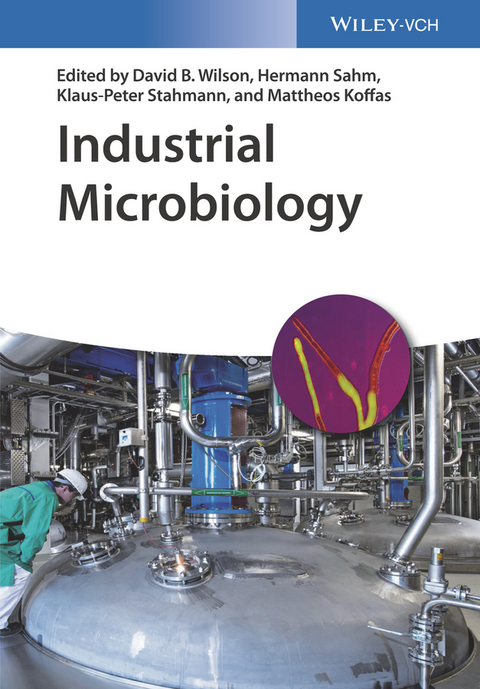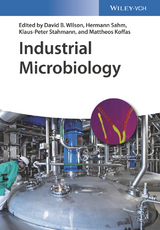Industrial Microbiology
Wiley-VCH (Verlag)
978-3-527-34035-4 (ISBN)
David Wilson, PhD, was a Professor of Biochemistry, Molecular and Cell Biology at Cornell University in Ithaca (USA). Hermann Sahm, PhD, is Emeritus Professor of Biotechnology at the University of Düsseldorf (Germany). Peter Stahmann, PhD, is Professor for Technical Microbiology at Brandenburg University of Technology Cottbus-Senftenberg in Senftenberg (Germany). Mattheos Koffas, PhD, is Professor of Biology at Rensselaer Polytechnic Institute in Troy (USA).
HISTORICAL OVERVIEW AND FUTURE PERSPECTIVE
Use of fermentation procedures prior to the discovery of microorganisms (Neolithic Era = New Stone Age until 1850)
Investigation of microorganisms and beginning of industrial microbiology (1850 until 1940)
Development of new products and processes: antibiotics and other biomolecules (after 1940)
Genetic engineering as successful tool for industrial microorganisms (after 1980)
Future perspectives: Synthetic microbiology
BIOPROCESS ENGINEERING
Introduction
Non-structured models
Oxygen transport
Heat generating aerobic processes
Product recovery
Modeling and simulation of reactor behavior
Scale-up
FOOD
Fermented foods
Microorganisms and metabolism
Yeast fermentations - Industrial application of Saccharomyces species
Vinegar - Incomplete ethanol oxidation by acetic acid bacteria such as Gluconobacter oxidans
Bacterial and mixed fermentations- Industrial application of lactic acid bacteria, with or without yeast or molds
Fungi as food
Conclusions and outlook
INDUSTRIAL ALCOHOLS AND KETONES
Introduction
Ethanol synthesis by Saccharomyces cerevisiae and Clostridium autoethanogenum
1,3-Propanediol synthesis by Escherichia coli
Butanol and isobutanol synthesis by clostridia and yeast
Acetone synthesis by solventogenic clostridia
Outlook
ORGANIC ACIDS
Introduction
Citric acid
Lactic acid
Gluconic acid
Succinic acid
Itaconic acid
Downstream options for organic acids
Perspectives
AMINO ACIDS
Introduction
Production of amino acids
L-Glutamate synthesis by Corynebacterium glutamicum
L-Lysine
L-Threonine synthesis by Escherichia coli
L-Phenylalanine
Outlook
VITAMINS, NUCLEOTIDES, CAROTENOIDS
Application and economic impact
L-Ascorbic acid (vitamin C)
Riboflavin (vitamin B2)
Cobalamin (vitamin B12)
Purine nucleotides
ß-Carotene
Perspectives
ANTIBIOTICS AND PHARMACOLOGICALLY ACTIVE COMPOUNDS
Microbial substances active against infectious disease agents or affecting human cells
beta-Lactams
Lipopeptides
Macrolides
Tetracyclines
Aminoglycosides
Claviceps alkaloids
Perspectives
PHARMACEUTICAL PROTEINS
History, main areas of application and economic importance
Industrial expression systems, cultivation and protein isolation and legal framework
Insulins
Somatropin
Interferons ? Application and manufacturing
Human granulocyte colony-stimulating factor
Vaccines
Antibody fragments
Enzymes
Peptides
View - Future economic importance
ENZYMES
Fields of application and economic impacts
Enzyme discovery and improvement
Production process for bacterial or fungal enzymes
Polysaccharide-hydrolyzing enzymes
Enzymes used as cleaning agents
Feed supplements - phytases
Enzymes for chemical and pharmaceutical industry
Enzymes as highly selective tools for research and diagnostics
Perspectives
MICROBIAL POLYSACCHARIDES
Introduction
Heteropolysaccharides
Homopolysaccharides
Perspectives
STEROIDS
Fields of applications and economic importance
Advantages of biotransformations during production of steroids
Development of production strains and production processes
Applied types of biotransformation
Synthesis of steroids in organic-aqueous biphasic systems
Side chain degradation at phytosterols by Mycobacterium to gain steroid intermediates
Biotransformation of cholesterol to gain key steroid intermediates
11-Hydroxylation by fungi during synthesis of corticosteroids
delta1-dehydrogenation by Arthrobacter for the production of prednisolone
17-keto reduction by Saccharomyces in testosterone production
Double bond isomerization of steroids
Perspectives
BIOLEACHING
Mineral-oxidizing acidophilic bacteria dissolve metals from sulfide ores
Bioleaching of copper, nickel, zinc and cobalt
Gold
Uranium
Perspectives
WASTEWATER TREATMENT PROCESSES
Introduction
Biological treatments for carbon, nitrogen and phosphorus removal
Wastewater treatment processes
Advanced wastewater treatment
Future perspectives
| Erscheinungsdatum | 22.01.2020 |
|---|---|
| Verlagsort | Weinheim |
| Sprache | englisch |
| Maße | 170 x 244 mm |
| Gewicht | 810 g |
| Themenwelt | Naturwissenschaften ► Biologie ► Mikrobiologie / Immunologie |
| Naturwissenschaften ► Chemie ► Technische Chemie | |
| Technik ► Umwelttechnik / Biotechnologie | |
| Schlagworte | Angewandte Mikrobiologie • applied microbiology • Biopolymere • biopolymers • Biotechnologie • Biotechnologie i. d. Chemie • Biotechnology • Biowissenschaften • Chemie • Chemistry • Life Sciences • Mikrobiologie • Polymer Science & Technology • Polymerwissenschaft u. -technologie |
| ISBN-10 | 3-527-34035-1 / 3527340351 |
| ISBN-13 | 978-3-527-34035-4 / 9783527340354 |
| Zustand | Neuware |
| Haben Sie eine Frage zum Produkt? |
aus dem Bereich




